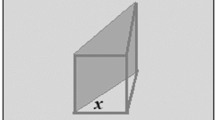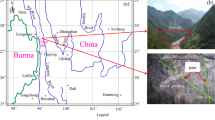Abstract
The accuracy of the established discrete fracture networks (DFNs) has a significant impact on the effectiveness of solving engineering problems, while the accuracy is affected by the selection of the model. Concerning the natural fracture facets, the existing method based on the Accuracy Representation Index (ARI) to select the circular or elliptical disc models is relatively complex, costly and time-consuming, and is not convenient for engineers at the field site. This study proposed two new empirical methods for engineers to quickly choose an appropriate model. The triangular, rectangular and diamond-shaped fractures are chosen as the basic shapes. For the fractures with other convex shapes, their ARI can be estimated on the basis of the three basic shapes. Moreover, a validation of a real case from an open-pit mine in the USA was made, three volunteers estimated the values of ARIc and ARIe of 56 fractures based on the proposed empirical methods, where ARIc and ARIe represent the values of ARI of circular and elliptical disc models, respectively, and the absolute error (er) from the empirical estimating method is calculated. The results show that the values of er are less than 0.1 and there is no obvious difference between results from the three volunteers. It illustrates that the proposed empirical methods are effective and applicable.












Similar content being viewed by others
References
Baecher GB, Lanney NA, Einstein HH (1977) Statistical description of rock properties and sampling. 19th U.S. Symposium on Rock Mechanics 5C1-1–5C1-8
Baghbanan A, Jing L (2007) Hydraulic properties of fractured rock masses with correlated fracture length and aperture. Int J Rock Mech Min Sci 44:704–719
Chen G, Song L, Liu L (2019b) 3D numerical simulation of elastic wave propagation in discrete fracture network rocks. Pure and Applied Geophysics 176(12):5377–5390
Chen Y, Ma G, Jin Y, Wang H, Wang Y (2019a) Productivity evaluation of unconventional reservoir development with three-dimensional fracture networks. Fuel 244:304–313
Chen S, Qiao C, Yang Z, Qiao C (2020) Application of stochastic joint network simulation to composite strata of shallow-buried long-span metro tunnels. Bull Eng Geol Environ 79:2085–2107
Dershowitz W, Hermanson J, Follin S, Mauldon M (2000) Fracture intensity measures in 1-D, 2-D, and 3-D at Äspö, Sweden. 4th North American Rock Mechanics Symposium. American Rock Mechanics Association 849–853
Guo J, Zheng J, Lü Q, Cui Y, Deng J (2020) A procedure to estimate the accuracy of circular and elliptical discs for representing the natural discontinuity facet in the discrete fracture network models. Comput Geotech 121:103483
Huang N, Jiang Y, Liu R, Li B (2017) Estimation of permeability of 3-D discrete fracture networks: An alternative possibility based on trace map analysis. Eng Geol 226:12–19
Huang N, Jiang Y, Liu R, Li B, Sugimoto S (2019) A novel three-dimensional discrete fracture network model for investigating the role of aperture heterogeneity on fluid flow through fractured rock masses. Int J Rock Mech Min Sci 116:25–37
Ivanova V (1998) Geologic and stochastic modeling of fracture systems in rocks. Massachusetts Institute of Technology, Cambridge
Jiang Q, Zhou C (2017) A rigorous solution for the stability of polyhedral rock blocks. Comput Geotech 90:190–201
Jin W, Gao M, Zhang R, Zhang G (2014) Analytical expressions for the size distribution function of elliptical joints. Int J Rock Mech Min Sci 70:201–211
Lei Q, Latham JP, Tsang CF (2017) The use of discrete fracture networks for modelling coupled geomechanical and hydrological behaviour of fractured rocks. Comput Geotech 85:151–176
Li L, Wu W, EL Nagger MH, Mei G, Liang R (2019) Characterization of a jointed rock mass based on fractal geometry theory. Bull Eng Geol Environ 78:6101–6110
Liu R, Zhu T, Jiang Y, Li B, Yu L, Du Y, Wang Y (2019) A predictive model correlating permeability to two-dimensional fracture network parameters. Bull Eng Geol Environ 78:1589–1605
McCallum D, Avis D (1979) A linear algorithm for finding the convex hull of a simple polygon. Inf Proc Lett 9(5):201–206
Meyer T (1999) Geologic stochastic modeling of rock fracture systems related to crustal faults. Cambridge: Massachusetts Institute of Technology
Sadeghiyeh SM, Hashemi M, Ajalloeian R (2013) Comparison of permeability and groutability of Ostur dam site rock mass for grout curtain design. Rock Mech Rock Eng 46(2):341–357
Shi Y, Song X, Li J, Wang G, Zheng R, Yulong F (2019) Numerical investigation on heat extraction performance of a multilateral-well enhanced geothermal system with a discrete fracture network. Fuel 244:207–226
Sun J, Zhao Z (2010) Effects of anisotropic permeability of fractured rock masses on underground oil storage caverns. Tunn Undergr Space Technol 25(5):629–637
Wang L, Chen W, Tan X, Tan X, Yang J, Yang D, Zhang X (2020) Numerical investigation on the stability of deforming fractured rocks using discrete fracture networks: a case study of underground excavation. Bull Eng Geol Environ 79:133–151
Wang Y, Li T, Chen Y, Ma G (2019) Numerical analysis of heat mining and geological carbon sequestration in supercritical CO2 circulating enhanced geothermal systems inlayed with complex discrete fracture networks. Energy 173(APR.15):92–108
Warburton PM (1980a) Stereological interpretation of joint trace data: Influence of joint shape and implications for geological surveys. Int J Rock Mech Min Sci Geomech Abstr 17(6):305–316
Warburton PM (1980b) A stereological interpretation of joint trace data. Int J Rock Mech Min Sci Geomech Abstr 17(4):181–190
Xiong F, Jiang Q, Xu C, Zhang X, Zhang Q (2019) Influences of connectivity and conductivity on nonlinear flow behaviors through three-dimension discrete fracture networks. Comput Geotech 107:128–141
Yin T, Chen Q (2020) Simulation-based investigation on the accuracy of discrete fracture network (DFN) representation. Comput Geotech 121:103487
Zhang L, Einstein HH, Dershowitz WS (2002) Stereological relationship between trace length and size distribution of elliptical discontinuities. Geotechnique 52(6):419–433
Zhang L, Einstein HH (2010) The planar shape of rock joints. Rock Mech Rock Eng 43(1):55–68
Zheng J, Kulatilake PHSW, Shu B, Sherizadeh T, Deng J (2014) Probabilistic block theory analysis for a rock slope at an open pit mine in USA. Comput Geotech 61(3):254–265
Zheng J, Kulatilake PHSW, Deng J (2015) Development of a probabilistic block theory analysis procedure and its application to a rock slope at a hydropower station in China. Eng Geol 188:110–125
Zheng J, Kulatilake PHSW, Shu B (2017) Improved probabilistic kinematic analysis procedure based on finite size discontinuities and its application to a rock slope at open pit mine in U.S. Int J Geomech 17(2):1–15
Zheng J, Wang X, Lü Q, Liu J, Guo J, Liu T, Deng J (2020) A contribution to relationship between volumetric joint count (Jv) and rock quality designation (RQD) in three-dimensional (3-D) space. Rock Mech Rock Eng 53(3):1485–1494
Zhao Y, Lu G, Zhang L, Wei Y, Guo J, Chang C (2020) Numerical simulation of shale gas reservoirs considering discrete fracture network using a coupled multiple transport mechanisms and geomechanics model. J Pet Sci Eng 195:107588
Acknowledgements
The authors thank Prof. Kulatilake PHSW, Dr. Shu Biao and Dr. Sherizadeh Taghi from the University of Arizona for providing help in collecting fracture geometry data of the field case.
Funding
This study was funded by the National Key R&D Program of China (2018YFC1505005 and 2019YFD1101101), the National Natural Science Foundation Projects (41972264 and 41772287) and the Key R&D Project of Zhejiang Province (2021C03159).
Author information
Authors and Affiliations
Corresponding author
Appendices
Appendix 1. A brief introduction to the Guo-procedure
Guo et al. (2020) developed a procedure to estimate the ARI of the circular and elliptical disc model with respect to the natural fracture facet. The procedure shows the process from inputting the raw data collected in the field to outputting the results, and a simplified summary of the procedure is as follows:
-
1.
Constructing a new polygonal fracture plane by fitting a plane
The shapes of natural fracture facets present various polygon. The vertex coordinates of one fracture facet can be obtained by some means. Since the fracture facet is not always a plane and has a slight curvature, we should fit a new polygonal plane by the vertex coordinates based on the least square method. Moreover, the normal vector of the new polygonal plane can be easily calculated.
-
2.
Three-dimensional shape planarization
The new polygonal plane is three-dimensional (3-D) in space and its dip direction and dip angle can be obtained by its normal vector. Owing to the mathematical convenience, it is very essential to convert the polygon to a two-dimensional (2-D) plane polygon, and the coordinate transfer based on dip direction and dip angle could achieve that.
-
3.
Calculating the 2-D polygon area and centroid coordinates
Usually, the vertexes of the polygon are disorderly. For the convenience of calculating its area and centroid coordinates, the Convex hull algorithm method (McCallum and Avis 1979) can be used to arrange the vertices of the polygon in an orderly manner counterclockwise or clockwise. The area of the 2-D polygon plane can be calculated by the vector cross product.
-
4.
Calculating the ARI of circular and elliptical disc model to represent the 2-D polygon
According to the definition of ARI, the circular or elliptical disc model has the same area and centre point as the polygon. The key to calculating ARI is to estimate the overlap area between the circle or elliptic and the polygon. Since the overlap area is an irregular figure, it is very difficult to calculate the area by an analytical solution. The Monte Carlo simulation can be used to estimate the irregular overlap area.
First, we constructed a calculating region to cover the entire area of the polygon and then calculated the area of the calculating region of Sregion. Next, a number of coordinate points labelled as N were generated in this region using the Monte Carlo simulation. The estimation of the overlap area of S depended on how many coordinate points were inside the overlap region, labelled as Nin. So S could be expressed as
Point in polygon strategies could be used to determine whether the coordinate point was inside this polygon. Taking one point as a starting point to make the horizontal radical line, the number of intersection points generated by the polygon and the radical line could be counted. If the number of intersection points was odd, the point had to be inside the polygon, and vice versa. Otherwise, the point was outside the polygon.
It should be noted that the estimating precision is mainly determined by N. Owing to the limitation of the computer memory and running time, N is not infinite. In consideration of the estimating precision and running time comprehensively, N = 1,000,000 is recommended.
For the circular disc model to represent the 2-D polygon fracture, it is very easy to calculate the overlap area between a circle and a polygon. However, the elliptical disc model has more parameters, such as the long-short axis length ratio ke, and the rotation angle γe. For the elliptical disc model to represent the 2-D polygon fracture, the overlap area was controlled by the two parameters of ke and γe. The range of rotation angle is from 1 to 180°, the long-short axis length ratio is more than 1, and the search method can be used to determine the upper limit value of ke. After the ranges of γe and ke are determined, the overlap area for each elliptical disc model with different combinations of γe and ke can be calculated, and the maximum value of overlap area is what we want.
Appendix 2
Rights and permissions
About this article
Cite this article
Guo, J., Zheng, J., Lü, Q. et al. Empirical methods to quickly select an appropriate discrete fracture network (DFN) model representing the natural fracture facets. Bull Eng Geol Environ 80, 5797–5811 (2021). https://doi.org/10.1007/s10064-021-02266-7
Received:
Accepted:
Published:
Issue Date:
DOI: https://doi.org/10.1007/s10064-021-02266-7




